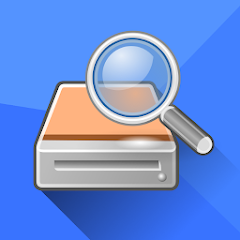Anúncios
Discover apps that bring back your memories and protect your photos on Android.

A photo recovery app can be the solution when important images disappear from your phone unexpectedly and cause serious concern.
These apps work by scanning Android’s memory and locating files that can still be restored, even after they have been deleted.
They are helpful allies in cases of carelessness, system errors or even when the memory card shows unexpected problems.
Want to make sure your memories are never lost? Discover the best photo recovery apps for Android phones right now!
What are photo recovery apps and why can they save your memories?
Recovering lost photos once seemed impossible, but technology proves otherwise. Today there are practical tools that bring deleted memories back and ease big concerns.
These apps act like little digital detectives, scanning your phone’s memory in search of forgotten records, ready to reappear before your eyes again.
With different features, each photo recovery app offers unique ways to restore images, whether in cases of mistakes, unexpected failures or painful accidental deletions.
In the end, these apps represent hope. After all, they are not just digital files: they are valuable memories, full of stories, ready to be revived and shared again.
How to choose the ideal app to recover your photos
When it comes to recovering lost photos, countless options promise miracles. But not all deliver consistent results, so careful choice is essential.
Each app comes with specific functions, from simple scans to advanced tools that require root. That is why comparing features is crucial before installing.
A good photo recovery app should balance convenience, efficiency and security. This way you get reliable results without compromising memory or personal data.
Understanding the differences between the main apps helps you decide with confidence. Want to find the best app for you? Discover the solution that perfectly fits your needs.
Main photo recovery apps on mobile
Recovering lost photos on your phone may seem impossible, but luckily there are various solutions created to bring back important memories that seemed gone.
These recovery apps offer different features, from simple options to advanced tools, allowing each user to find the ideal solution for their specific needs.
DiskDigger
App

DiskDigger
DiskDigger is known as a photo recovery app for Android devices, delivering quick results both in free versions and in paid editions.
It performs deep scans when the phone is rooted, significantly increasing the chances of restoring photos deleted recently or even long ago.
In the non-root version, DiskDigger can still find thumbnails and reduced versions of images, ensuring some recovery even under limited conditions.
Its simple interface makes the process intuitive, letting any user run scans without complications, turning desperate moments into practical solutions.
Main features and how it works
DiskDigger works by performing detailed scans in the phone’s memory, showing image results that can still be recovered with just a few taps.
It runs both on rooted and non-rooted devices, offering different outcomes depending on scan depth and the access level available.
In practice, the app organizes results in lists, letting users manually select which images they want to restore immediately.
This photo recovery app is compatible with many Android models, ensuring accessibility for users facing unexpected data loss.
Difference between use with and without root
When used on non-rooted devices, DiskDigger finds only thumbnails and reduced image versions, delivering more limited results to the user.
On rooted phones, the app performs deeper scans, going through internal memory sectors and recovering photos in higher quality.
This difference exists because root access unlocks restricted system areas, letting the app explore data that would normally be inaccessible.
Therefore, users with rooted devices can take full advantage of DiskDigger, greatly boosting their chances of successful recovery.
Advantages and limitations
Among its advantages are ease of use, an intuitive interface and the possibility of running quick scans even without root access.
Another advantage is compatibility with different image formats, offering flexibility to restore various types of recently deleted files.
On the other hand, its biggest limitation without root is recovering only reduced versions, which may frustrate users seeking original quality.
Also, effectiveness depends on the time since deletion, because the sooner the app is used, the greater the chances of success.
When is it worth using DiskDigger
DiskDigger is useful in urgent situations, such as accidental deletion of important photos, offering immediate hope to restore records without technical complications.
It is also recommended for those who want to recover images easily, without relying on computers or complex recovery software.
On rooted devices, its effectiveness is even higher, making the app a powerful ally to save memories that seemed permanently lost.
If you are looking for a reliable Android photo recovery app, DiskDigger certainly stands out among the top available choices.
DigDeep Image Recovery
App

DigDeep Image Recovery
DigDeep Image Recovery stands out for its practicality, as it does not require root to start searching for lost photos in Android’s memory.
Its scan covers both internal storage and the SD card, raising the chances of success when recovering different types of deleted images.
Results are shown in an organized way, in folders, making it easier to view and choose what truly deserves to be restored.
Despite its simplicity, the app delivers what it promises, serving as a quick and free option to recover accidentally deleted memories.
How the app recovers photos
DigDeep works by scanning the device’s memory, including internal storage and SD card, identifying image files that have not yet been overwritten.
This process increases the chances of locating records that seemed permanently deleted, especially when deletion occurred recently and the space has not been reused.
The app organizes results in folders, making navigation easier and letting the user quickly find specific images among the recovered files.
Thus, DigDeep proves efficient as a photo recovery app for Android, combining convenience with satisfying results in cases of accidental deletion.
Interface and ease of use
DigDeep Image Recovery offers a simple interface that organizes recoverable images into categories, making selection quick and straightforward for any user.
This feature ensures accessibility, allowing even those without tech experience to use the app without feeling intimidated or confused during the process.
Commands are direct and intuitive, avoiding excessive menus or technical options, which helps keep the Android experience smooth and pleasant.
With just a few taps, users can see results and choose which files to restore, turning photo recovery into an easy task.
Strengths and weaknesses of DigDeep
Among its strengths is not requiring root, letting any user attempt recovery without modifying the system.
In addition, its free use makes it accessible for those seeking quick solutions without extra costs, especially in unexpected data loss cases.
On the downside, DigDeep may show limits in scan depth, not reaching the same effectiveness as more advanced tools.
Another drawback is the lack of frequent updates, which may affect compatibility with newer Android versions.
Usage recommendations
DigDeep is recommended for everyday situations, like accidental deletions or brief glitches that caused the loss of photos stored on the phone.
It is also a valid option for users wanting to quickly restore SD card photos without turning to computers or complex software.
Its use is suggested as a first recovery attempt, due to its practicality and quick results without demanding long processes.
For those seeking a photo recovery app without complications, DigDeep is a good choice for handling simple Android losses.
Dumpster
App

Dumpster
Dumpster works differently, acting like a smart recycle bin that stores everything you delete after installing it on your phone.
This means it does not recover older files but prevents future losses by providing a safe place to quickly restore photos.
It also offers a cloud backup option, ensuring extra protection if you need to free up space or format your Android device.
How preventive file recovery works
Unlike other apps, Dumpster does not run later scans but automatically keeps deleted files, offering a practical solution for the user.
This strategy ensures that any accidental deletion can be quickly reversed, making the process far simpler than relying on traditional scans.
The app creates a secure repository where users can easily access deleted files, choosing to restore only what they want.
In this way, Dumpster proves that a photo recovery app can also act preventively, stopping valuable memories from disappearing without return.
Difference between free and premium versions
In its free version, Dumpster works as a basic recycle bin, letting users restore deleted files locally, easily and without technical complications.
The premium version adds cloud backup, offering extra security against device failures or when you need to free up space.
With the paid plan, users can further customize the experience, gaining more control and peace of mind over deleted Android files.
This makes the premium version ideal for those seeking continuous protection, especially in cases of heavy use or dependence on important photos.
Advantages over other recovery apps
One main advantage of Dumpster is its practicality, since it does not require root or advanced processes to restore recently deleted files.
Another strong point is prevention: by acting immediately, the app stops important data from being overwritten, something common with traditional recovery methods.
Its user-friendly interface makes it easy for anyone to use, even those who never tried recovery apps before.
In addition, cloud backup support places Dumpster ahead of many options, delivering convenience and extra security for users.
Limitations and important considerations
Despite the advantages, Dumpster can only protect files deleted after installation, making it useless for images removed earlier from the device.
This limits its emergency use but reinforces its purpose as a preventive tool, helping avoid future problems with lost photos.
Another point to note is the space occupied by stored files, which may require regular management to avoid internal memory overload.
Even so, for those wanting a preventive photo recovery app, Dumpster remains a smart choice for Android.
Undeleter Recover Files & Data
App

Undeleter Recover Files & Data
Undeleter Recover Files & Data is powerful, especially on rooted phones, offering advanced searches for different formats beyond traditional images.
Even without root, the app still delivers limited results, focusing on recovering cache files, but it can still help in emergencies.
Its free version contains ads, while the premium unlocks extra features, delivering more convenience during use and a better experience for demanding users.
For those seeking a photo recovery app with advanced resources, Undeleter may be the ideal alternative, especially on rooted Android devices.
Available features with and without root
Without root, Undeleter can recover images from app caches, offering basic support for those who need quick solutions in emergencies.
With root enabled, it expands its features, scanning memory and SD cards deeply, greatly increasing the chances of successful recovery.
This difference shows how root access can turn the app into a complete tool, delivering results that surpass simpler applications.
Thus, Undeleter positions itself as an efficient photo recovery app, adapting to the needs of each user and level of technical knowledge.
File types supported beyond photos
Besides photos, Undeleter can also recover other files, including videos, music, documents and even temporary data from Android apps.
This breadth expands its usefulness, making it a more complete tool for restoring not only visual memories but also various types of content.
Many users rely on it to recover work records, personal recordings or even songs deleted accidentally from phone storage.
This variety of supported formats reinforces the app’s versatility, putting it ahead of solutions limited only to images.
Free version vs premium
Undeleter’s free version includes ads and some restrictions, but it still offers enough features to run basic recovery tests.
The premium version removes ads and unlocks extra functions, like background scans, providing greater convenience and speed during recovery.
This difference lets users choose between a cost-free initial experience or a full version for more demanding needs.
Thus, the paid version becomes appealing for those who want ongoing convenience and more effective results in various deletion scenarios.
Ideal scenarios for using Undeleter
Undeleter is recommended in critical situations, such as accidental deletion of important photos, videos or documents stored on Android.
It is especially indicated for users with rooted devices, who can fully explore advanced features and run deeper memory recoveries.
It can also be useful on SD cards, letting users restore externally stored content without needing a computer.
For those seeking a reliable and multifunctional photo recovery app, Undeleter presents itself as an effective solution for different digital needs.
Conclusion
Throughout this article, we have seen how different apps offer practical solutions to recover deleted photos on Android, each with its own interesting features.
These tools stand out for bringing back valuable memories, showing that technology can turn desperate moments into relief through simple processes.
Choosing the ideal app depends on your needs: scan depth, ease of use or even prevention to avoid future important losses.
Enjoyed it? Want to learn more about protecting your memories? Then check out the article below and discover everything about the Dumpster photo recovery app!
Recommended Content
